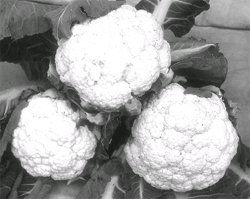Poison in every bite
 In India, very little attention has been given to the accumulation of heavy metals in food products though all edible food products such as vegetables, cereals and fruits are replete with these toxins.
In India, very little attention has been given to the accumulation of heavy metals in food products though all edible food products such as vegetables, cereals and fruits are replete with these toxins.
A study conducted by cpcb and the department of agriculture, Calcutta University, which was reported in The Telegraph in July 25, 1997, shows that vegetables grown at Dhapa-Bamtala, a small locality in Calcutta, contain toxic metals. One-fourth of the vegetables sold in the city's markets comes from this area. Dhapa-grown cauliflower contains 44.1mg of lead and 3.3mg of cadmium in every kilogramme of produce. So if anyone has eaten 23 kg of Dhapa-grown cauliflowers, he or she has also ingested about one 1mg of lead and about 0.08mg of cadmium. The who standard of lead is 0.5 mg per kg of body weight per person and for cadmium it is 0.0083mg/kg.
Two studies conducted by the icmr in 1993 and 1996 also reveal that canned food products contain metals like lead, aluminium, tin and zinc. After storing the product for one year, the content of tin in canned food products kept at room temperature increased from 27 mg/kg to 542 mg/kg - almost 7 to 15 times more than when these products were canned.
The exposure of heavy metals to the human body can be either through ingestion, inhalation or skin. Infants and foetuses are exposed to metals through breast milk or trans-placental transfer (transfer of blood from the mother to the foetus). Heart and chronic lung diseases are some of the known effects of heavy metal pollution (see box: Lead story ).
Household goods
The use of heavy metals in household items has grown over the years. No one is spared here. From the walls to the floors, kitchen to the dining room, nothing is safe. Be it lead, mercury, cadmium or chromium, hardly any household item is safe from these toxic metals.
One of the social evils of Indian society is food adulte-ration, a practice commonly found in colouring of turmeric powder with lead chromate and use of non-permitted metal colours in food and beverages. And to think of it, turmeric is used to prepare every Indian meal.
At times, even dishes are not safe. Porcelain dinnerware is painted with pigments which contain lead, cadmium, chromium and cobalt. The us Food and Drug Administration has set limits on its use in European and Chinese porcelain tableware. In India, there are a number of small-scale industries, located all over the country, which make glazed ceramic potteries. And it is extremely difficult to keep a check on every one of them. But, at least, the public should be made aware that foods with high acid content should not be stored in ceramics and old ceramicware should never be used to serve food.
Then there are the plastic bags, widely used to carry vegetables and other food stuffs, including milk and cheese. Ingredients of the colours used in these bags are generally lead and cadmium. When fatty food materials are packed inside, there is a chance of food absorbing the paint.
Paints also contain varying amounts of lead. Every house is a myriad of colours. You can choose the colour, but not the contents. The cheaper the paint, higher the lead content. For instance, very high amounts of lead is used in the making of Ganesha and Durga idols. And when these are immersed into rivers or seas after the festivals, they contribute substantially to the high lead content in the water. Festivals bring with them heavy metal exposure. The festival of colours, Holi, besides excitement brings along with it a fair share of toxic pollutants. These colours contain lead and mercury. Both these metals reach the blood stream directly through the skin, says Amit Nair, environmental toxicologist of cse .
Then there are the plastic toys, a child's best friend. These toys contain hazardous levels of lead and cadmium. An independent laboratory analysis has revealed that some of the toys, even from reputed companies, release toxic metal dust to their surfaces. It was reported in the Multinational Monitor in 1997 that lead or cadmium contaminated dust is hazardous since it can enter the body by licking, chewing or inhalation. As the toys get older, more of the metal dust is liberated.
| Killing Fields | ||
| Heavy metals cause a number of distress | ||
| HEAVY METAL | SOURCES | HEALTH EFFECTS |
| LEAD | Mining, coal, automobile,paper, dyeing,petrochemicals, etc. | Learning disability;mental retardation |
| CHROMIUM | Leather/tannery, thermal power plants, mining fertilisers, textile, photography | Bronchial asthma, allergies, |
| CADMIUM | Coal, nuclear and coal power plants,batteries, ceramics, toys | Itai Itai disease (fragile bones) |
| NICKEL | Mining, coal power plants,phosphate fertiliser, chocolate, automobile, electroplating | Dermatitis, pneumonia |
| MERCURY | Mining, paper and pulp, coal power plants, cement, pesticides, cosmetics | Minimata disease (disorder of the nervous system) |
| ZINC | Phosphate fertilisers, distillery,pharmaceuticals | Fever |
| IRON | Coal mining, | Skin becomes sensitive to light |
